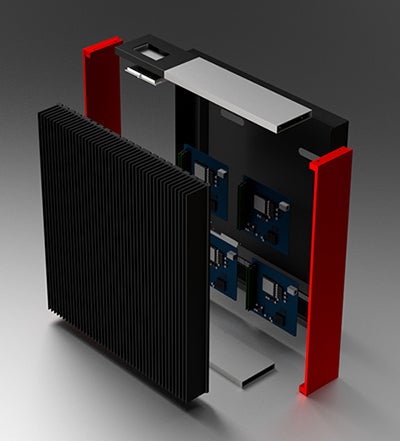
Posted on 11/19/2015 12:34:49 PM PST by ShadowAce

This year's Blender Conference was filled with all kinds of interesting talks about interesting uses of Blender and open source technology. A particularly novel one that caught my eye was nestled neatly within the art and pipeline presentation for the Blender Institute's open movie, Cosmos Laundromat. In that talk, Paul Benoît of Qarnot Computing spoke about his company's very unique render farm.
 It's common knowledge that high-performance computing (HPC) generates a lot of heat. At HPC datacenters, a lot of time and energy is spent figuring out how to cool these powerful computers. Not only does this have a significant environmental impact, Qarnot sees this as wasted energy (and wasted opportunity). As a solution, they've designed a "digital heater" that they call a Q.rad.
It's common knowledge that high-performance computing (HPC) generates a lot of heat. At HPC datacenters, a lot of time and energy is spent figuring out how to cool these powerful computers. Not only does this have a significant environmental impact, Qarnot sees this as wasted energy (and wasted opportunity). As a solution, they've designed a "digital heater" that they call a Q.rad.
The device is really just a high-performance computing node sold as a space heater. The Q.rad provides computation power for HPC needs while also providing free heat where they're installed. Even better, this is all made possible because of open source software like Linux, Docker, and (of course) Blender.
Get the details in this interview with Paul Benoît of Qarnot Computing.

The Q.rad is the first heater to use embedded processors as a heat source. Totally silent, it gets computing instructions through the Internet and the heat produced by workload processing provides free and efficient heating for homes, public buildings, and offices.
Along with the Q.rad, Qarnot developed Q.ware, the software platform that dynamically and securely distributes our clients' computations on our Q.rad digital heater farm.
Fully automated, the Q.ware platform is in charge of computing node selection, payload boot sequence, data distribution and output results collection, processors frequencies adjustment, and job management.
Open source mainly allows us to adapt applications to our specific infrastructure (headless, diskless, etc.). Beyond licensing economical and technical issues, it's often a pain to integrate commercial closed source applications. They are rarely designed to be versatile, and editors' commercial priorities make it difficult to have custom features.
We also believe that most infrastructure-intensive software will end up with a really professional-grade open source player, as is the case for 3D rendering with Blender. It's also in our common interest to take part in the development to make that software as versatile as possible. That's why we took part in Blender's Flamenco project.
We either use customers' fiber-to-the-home or a dedicated fiber-to-the-building depending on the site size. Within the building, we use a dedicated LAN.

We provide our client with a global throughput in terms of GHz, allowing us to involve more nodes with lower frequencies. In the case of Cosmos Laundromat, it was a requirement to have full-speed nodes. So we had to statically allocate some jobs to specific nodes we were able to use without bothering hosts, notably within a school closed in July.
Our infrastructure integrates encryption and authentication security modules to propose an end-to-end protection of our clients' data. The stateless/diskless architecture is also a protection against data analysis. Concerning the hosts, we monitor the integrity of our heaters to discard mistrusted ones until our next maintenance visit. Of course, the heater can still compute non-sensitive jobs to generate heat.

You kids get off my lan! ;-)
PFFT! I’ve got an air-cooled gaming rig, a stack of network switches, and a stack of NAS and server devices in my office that keep the temperature at a comfortable 83 around the clock. This isn’t new. Enthusiasts are used to their homemade heaters.
Cool. Not only do I use my neighbor’s IP to download via torrent, I can also use this sucker to heat up my place!
Unless someone else is paying for the electricity to run these computers, the heat isn’t “free” by any stretch of the imagination. Also, during the summer months, you’ll have to pay extra to cool the room because these ‘heaters’ are always running, or there isn’t much point in them.
I'm thinking only people in certain climes would be interested.
“free heat” heh..
What someone needs to do it turn all radio waves into heat. I have about 50 wifi connections pretty close to my house.
Something you can plug anything into, IE phone lines, cable that somehow turns it all into heat.
There “free” energy!
Might be able to heat a very small space. lol
This is a poor concept. Much better to put large HPCs next door to power plants and dump the heat into their cycles. You have the power you need to run the HPC right there and you can significantly improve the power cycle efficiency with the waste heat. The HPC can have the normal physical and logical security safeguards. Distributing high power servers that dump a lot of waste heat into houses and apartments may work in the winter, but not in summer. Power plants can use the heat hear-round.
A good friend of mine patented this some years ago.
Heat? How about electricity? I recall one AM radio project that used a long wire and a neon bulb...if you lived in the vicinity of a decently powered AM station...

Does it make hot cocoa?
Free? Hardly. It’s an electric heater allowing consumers to donating power consumption and bandwidth to the shrewd seller. No thanks.
This sort of thing is hardly new. I heated half my house with my cryptocurrency mining rig two winters back. (Basically a large desktop computer with 4 of the most expensive graphics cards you could buy mounted on it, with a 20” box fan aimed at it point blank.) Made money and saved money at the same time since that was when propane prices were skyrocketing in our area.
If this guy knows as much about computing as he does about electricity, I wouldn’t trust him to send an email. the amount of heat energy flowing into a home through the internet isn’t enough to warm a gnat’s ear hair. All of the heat energy in computing comes through the electrical outlet, paid for by the homeowner. Electric heat is one of the most costly ways to heat your home, equivalent in cost to about $5.00 per gallon gasoline.
bump for later
Disclaimer: Opinions posted on Free Republic are those of the individual posters and do not necessarily represent the opinion of Free Republic or its management. All materials posted herein are protected by copyright law and the exemption for fair use of copyrighted works.